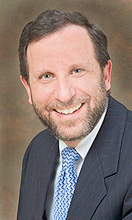News
Prize awarded for ALS research
-
 Print
Print -
 Comments
Comments
-

“We think this biomarker has a lot of potential as a way to monitor progression of the disease, which will be helpful in developing new medications, and possibly as an aid in diagnosis.”
A UB dermatologist has won a $50,000 Prize4Life ALS Biomarker Challenge Discovery Prize for developing a promising biomarker that can be used to assess disease progression of amyotrophic lateral sclerosis, or ALS, also known as Lou Gehrig's disease.
Harvey Arbesman, clinical assistant professor of dermatology and social and preventive medicine, working with colleagues from Columbia University Medical School and the Eleanor and Lou Gehrig MDA/ALS Research Center, adapted a technology commonly used in the cosmetic industry, the Cutometer®, to noninvasively measure skin elasticity.
In a pilot study, Arbesman and colleagues were able to show that changes in skin elasticity correlated with disease progression in ALS patients.
“When we looked at ALS patients, even at baseline, there was a very significant difference in skin elasticity compared to age-matched controls,” said Arbesman. “As patients got sicker, the elasticity of the skin decreased. We think the skin is reflecting in some manner what is going on in the nervous system.
“We think this biomarker has a lot of potential as a way to monitor progression of the disease, which will be helpful in developing new medications, and possibly as an aid in diagnosis. It may also help us to better understand the underlying disease process itself.”
Arbesman presented his findings recently at the American Association of Neurology meeting in Seattle.
The $50,000 prize is one of only two awarded in this “breakthrough competition” sponsored by Prize4Life, a nonprofit organization founded to accelerate research in Lou Gehrig's disease. Arbesman will use the funds to continue research on the biomarker and to compete for the $1 million ALS Biomarker Challenge, sponsored by Prize4Life.
ALS, a progressive neurodegenerative disease that affects nerve cells in the brain and the spinal cord, is a fatal condition that for decades has stymied those searching for a treatment or cure.
Arbesman, who previously had never conducted ALS-related research, was one of five winners in the first track of the competition, which called for theoretical papers describing how entrants would develop an ALS biomarker. Those winners were announced in spring 2007.
When Prize4Life called for the actual identification and validation of an ALS biomarker, Arbesman recruited a team that shared his interest in the connection between the nervous system and skin. The team entered patients into a pilot study to test the theoretical biomarker, using the Cutometer®, which can detect minute changes in the elasticity of the skin.
Arbesman and his team were able to precisely measure skin elasticity in these patients, showing that skin elasticity decreases as the disease progresses.
Arbesman maintains an active dermatology practice, and is founder and vice president of ArbesIdeas, a health-care-related research and development company. One of the company's goals is to promote creative thinking in developing medical hypotheses.
“You need new hypotheses to account for different anomalies to existing theories,” Arbesman notes. “Or sometimes you need a new theory to generate a new therapy or simply to understand disease in general. Such hypotheses are what really create leaps in our understanding of critical problems.”

Reader Comments